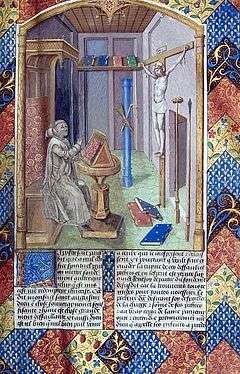Ludolph of Saxony
Ludolph of Saxony (c. 1295 – 1378), also known as Ludolphus de Saxonia and Ludolph the Carthusian, was a German Roman Catholic theologian of the fourteenth century.

His principal work, first printed in the 1470s, was the Vita Christi (Life of Christ).[1] It had significant influence on the development of techniques for Christian meditation by introducing the concept of immersing and projecting oneself into a Biblical scene about the life of Jesus which became popular among the Devotio Moderna community, and later influenced Ignatius of Loyola.[2]
Biography
Little is known about Ludolph of Saxony's life. He may have been born about 1295, but this is uncertain.[3] We have no certain knowledge of his native country; for in spite of his surname, "of Saxony", he may well, as Jacques Échard remarks, have been born either in the Diocese of Cologne or in the Diocese of Mainz, which then belonged to the Province of Saxony. He first joined the Dominicans, possibly in about 1310,[4] passed through an excellent course of literary and theological studies, and may have learnt the science of the spiritual life at the school of Johannes Tauler and Henry Suso, his contemporaries and companions in religion.
After about thirty years spent in the active life, he was in 1340 given permission to become a Carthusian, on the grounds that he felt a calling to the stricter life of silence and solitude practiced by that order;[5] in that year he entered the Charterhouse (Carthusian monastery) of Strasburg. Three years later he was called upon to govern the newly founded (1331) Charterhouse of Koblenz; but scruples of conscience led him to resign his office of prior in 1348. Having again become a simple monk, first at Mainz and afterwards at Strasburg, he spent the last thirty years of his life in retreat and prayer, and died on 13 April 1378 an octogenarian, universally esteemed for his sanctity, although he never seems to have been honoured with any public cult.
Works
Ludolph is principally remembered for two works:
- A Commentary upon the Psalms, concise but excellent for its method, clearness and solidity. He especially developed the spiritual sense, according to the interpretations of St. Jerome, St. Augustine, Cassiodorus and Peter Lombard. This commentary, which was very popular in Germany in the Middle Ages, has passed through numerous editions, of which the first dates from 1491, and that of Montreuil-sur-Mer is from 1891.
- The Vita Christi, his principal work, is not a simple biography, but a history, a commentary on the Gospels with large texts borrowed from the Fathers, a series of dogmatic and moral dissertations, of spiritual instructions, meditations and prayers, in relation to the life of Christ, from birth to His Ascension. It has been called a summa evangelica, so popular at that time, in which the author has condensed and resumed all that over sixty writers had said before him upon spiritual matters.
It is possible that Ludolph also wrote the Speculum Humanae Salvationis.[6] Other treatises and sermons now either lost or very doubtful have also been attributed to him.
At times, the famous work The Imitation of Christ has been attributed to Ludolph of Saxony. Even though this is incorrect, it is certainly the case that the author of that work draws on Ludolph's thought.
See also
Notes
- Catholic encyclopedia
- Christian spirituality: an introduction by Alister E. McGrath 1999 ISBN 978-0-631-21281-2 pages 84–87
- The older Catholic Encyclopedia says 1300; for the estimate of 1295, see Charles Abbott Conway, The Vita Christi of Ludolph of Saxony and late medieval devotion centred on the incarnation: a descriptive analysis, (Salzburg, 1976), p1
- This is supposition, based on his estimated date of birth, and how old he is likely to have been on joining the Dominicans.
- Charles Abbott Conway, The Vita Christi of Ludolph of Saxony and late medieval devotion centred on the incarnation: a descriptive analysis, (Salzburg, 1976), p1
- Adrian Wilson and Joyce Lancaster Wilson (1984), A Medieval Mirror, Berkeley: University of California Press, CDlib.org p.26-7.
References
